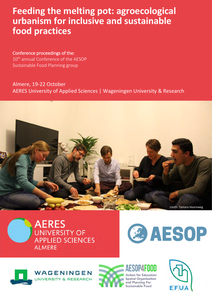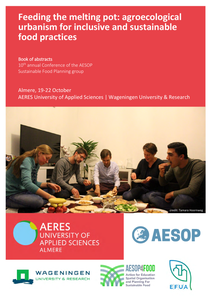This chapter explores the use of “responsive” or “interactive” urban media technologies as a tool or “building block” in the (re)design of urban public spaces. This is especially relevant as in the last two decades, urban development and digital technologies have brought out new types of urban typologies and practices often referred to as “networked urbanism.” These typologies and practices bring out specific challenges with regard to their functioning as public space. We argue that responsive technologies could reinforce qualities of public space in this condition of “networked urbanism”; however, their implementation demands new strategies and above all new forms of cooperation between disciplines such as architecture, urban design, and urban interaction design. To aid such an approach, this chapter introduces a heuristic of five mechanisms of responsive media. These are meant to function as a shared vocabulary aiding designers of various backgrounds to collaborate in an interdisciplinary design process for public spaces in a broader development of networked urbanism.
DOCUMENT
This book discusses the way that a nature-driven approach to urbanism can be applied at each of the urban scales; architectural design, urban design of neighborhoods, city planning and landscape architecture, and at the city and regional scales. At all levels nature-driven approaches to design and planning add to the quality of the built structure and furthermore to the quality of life experienced by people living in these environments. To include nature and greening to built structures is a good starting point and can add much value. The chapter authors have fiducia in giving nature a fundamental role as an integrated network in city design, or to make nature the entrance point of the design process, and base the design on the needs and qualities of nature itself. The highest existence of nature is a permanent ecosystem which endures stressors and circumstances for a prolonged period. In an urban context this is not always possible and temporality is an interesting concept explored when nature is not a permanent feature. The ecological contribution to the environment, and indirect dispersion of species, from a temporary location will, overall add biodiversity to the entire system.
LINK
These conference proceedings to the 10th annual conference of the AESOP Sustainable Food Planning group are organised as follows: the following four sections contain the short papers belonging to the four tracks that made up the conference (social inclusion; urban agriculture; urban planning, design and development; food governance). The last section consists of the abstracts of the book and poster presentations, a short report on the YAP workshop held at the first day of the conference, and a short report on the excursion organised at the last conference day.
DOCUMENT

This book contains the abstracts to the sessions presented at the AESOP Sustainable Food Planning conference in 2022. The conference was made up of four tracks: social inclusion; urban agriculture; urban planning, design and development; food governance.
DOCUMENT

In the debate about smart cities, an alternative to a dominant top-down, tech-driven solutionist approach has arisen in examples of ‘civic hacking’. Hacking here refers to the playful, exploratory, collaborative and sometimes transgressive modes of operation found in various hacker cultures, this time constructively applied in the context of civics. It suggests a novel logic to organise urban society through social and digital media platforms, moving away from centralised urban planning towards a more inclusive process of city-making, creating new types of public spaces. This book takes this urban imaginary of a hackable city seriously, using hacking as a lens to explore examples of collaborative city-making enabled by digital media technologies. Five different perspectives are discussed. Hacking can be understood as (1) an ethos, a particular articulation of citizenship in the network era; (2) as a set of iterative and collaborative city-making practices, bringing out new roles and relations between citizens, (design) professionals and institutional actors; (3) a set of affordances of institutional structures that allow or discourage their appropriation; (4) a critical lens to bring in notions of democratic governance, power struggles and conflict of interests into the debate on collaborative city-making; and (5) a point of departure for action research. After a discussion of these themes, the various chapters in the book are briefly introduced. Taken together they contribute to a wider debate about practices of technology-enabled collaborative city-making, and the question how city hacking may mature from the tactical level of smart and often playful interventions to a strategic level of enduring impact.
DOCUMENT

In human-controlled environments and in cultivated landscapes, the plants accommodate social, cultural and economic needs. This article will focus on the use of plants for agriculture, urban planning, forestry, environmental education and indoor decoration in The Netherlands. This exploration, based on literature review and observations, reveals mostly anthropocentric, instrumental and unsustainable practices. In urban landscapes plants are pushed to the margins, if not entirely eradicated. This article shows that moral recognition of plants is an ethical imperative, which is also critically important to achieve environmental sustainability. In line with ecocentric ethics and in the interest of long-term sustainability, this article suggests alternative, more ethical and sustainable ways of relating to plants in The Netherlands and beyond. This is the Author’s Original Manuscript of an article published by Taylor & Francis in Journal of Urbanism: International Research on Placemaking and Urban Sustainability, on October 2018, available online: https://www.tandfonline.com/doi/full/10.1080/17549175.2018.1527780 https://doi.org/10.1080/17549175.2018.1527780
MULTIFILE

In human-controlled environments and in cultivated landscapes, the plants accommodate social, cultural and economic needs. This article will focus on the use of plants for agriculture, urban planning, forestry, environmental education and indoor decoration in The Netherlands. This exploration, based on literature review and observations, reveals mostly anthropocentric, instrumental and unsustainable practices. In urban landscapes, plants are pushed to the margins, if not entirely eradicated. This article shows that the moral recognition of plants is an ethical imperative, which is also critically important in order to achieve environmental sustainability. In line with ecocentric ethics and in the interest of long-term sustainability, this article suggests an alternative, more ethical and sustainable ways of relating to plants in The Netherlands and beyond. This is an Accepted Manuscript of an article published by Taylor & Francis in "Journal of Urbanism: International Research on Placemaking and Urban Sustainability" on 10/11/18 available online: https://doi.org/10.1080/17549175.2018.1527780 LinkedIn: https://www.linkedin.com/in/helenkopnina/
MULTIFILE

The World Health Organization (WHO) strives to assist and inspire cities to become more “age-friendly”, and the fundamentals are included in the Global Age-Friendly Cities Guide. An age-friendly city enables residents to grow older actively within their families, neighbourhoods and civil society, and o ers extensive opportunities for the participation of older people in the community. Over the decades, technology has become essential for contemporary and future societies, and even more imperative as the decades move on, given we are nearly in our third decade of the twenty-first century. Yet, technology is not explicitly considered in the 8-domain model by the WHO, which describes an age-friendly city. This paper discusses the gaps in the WHO’s age-friendly cities model in the field of technology and provides insights and recommendations for expansion of the model for application in the context of countries with a high human development index that wish to be fully age-friendly. This work is distinctive because of the proposed new age-friendly framework, and the work presented in this paper contributes to the fields of gerontology, geography urban and development, computer science, and gerontechnology. Original article at MDPI; DOI: https://doi.org/10.3390/ijerph16193525 (This article belongs to the Special Issue Quality of Life: The Interplay between Human Behaviour, Technology and the Environment)
MULTIFILE

Transitions can be facilitated through collective networked action, moving from coordinated learning towards more forceful interventions. This coordinated effort is challenging in more extended learning and innovation networks. Creating and maintaining an overview of activities within such a network and connecting them to a common cause can be a powerful approach. A tool named MissionMapping was developed in an iterative process in applied co-design research. With the tool, we intend to allow for a more holistic perspective when navigating the activities of the network related to the transition by working towards more of an overview of the questions and activities within the network. This article describes three cases in which MissionMapping was applied to facilitate synergy in networks of people collaborating on societal challenges. A cross-case analysis was done to develop insights on how MissionMapping supports the synergy of goals and projects within societal challenges. MissionMapping allows participants to build their mission landscape. They combine individual activities to create shared territories. The tool was developed in an iterative process. In the three cases, different versions of the tool were used during live workshops. After the cases and applying MissionMapping in other cases, the tool results in a flexible set that can be adapted to different purposes for a workshop and adopted by others who like to apply the tool. The article presents insights resulting from a cross-case analysis of applying the MissionMapping tool. One insight was that it is difficult to keep track of adjustments over time when the network dynamics change. Additionally, we found that while preparing the workshop, adjusting and printing the tiles cost time and are not easily transferable to others who might be interested in applying the tool. Navigating the mission resulted in increased enthusiasm for the topic at hand. The form factor also seems to contribute to a sense of agency. However, the increased agency does not automatically transfer to actions, as organisations are often inflexible. MissionMapping stimulates the development of a shared language through the landscape metaphor. This helps to cross boundaries in multidisciplinary networks. Capturing and transferring insights visually and digitally was quite challenging. Further exploration is needed to find an effective method. It is difficult to capture the impact of the MissionMaps and requires monitoring over time. For now, we conclude that it benefits collaboration, creates overviews in complex networks, and may fuel idea generation.
DOCUMENT

Comprehensive understanding of the merits of bottom-up urban development is lacking, thus hampering and complicating associated collaborative processes. Therefore, and given the assumed relevancies, we mapped the social, environmental and economic values generated by bottom-up developments in two Dutch urban areas, using theory-based evaluation principles. These evaluations raised insights into the values, beneficiaries and path dependencies between successive values, confirming the assumed effect of placemaking accelerating further spatial developments. It also revealed broader impacts of bottom-up endeavors, such as influences on local policies and innovations in urban development.
MULTIFILE
